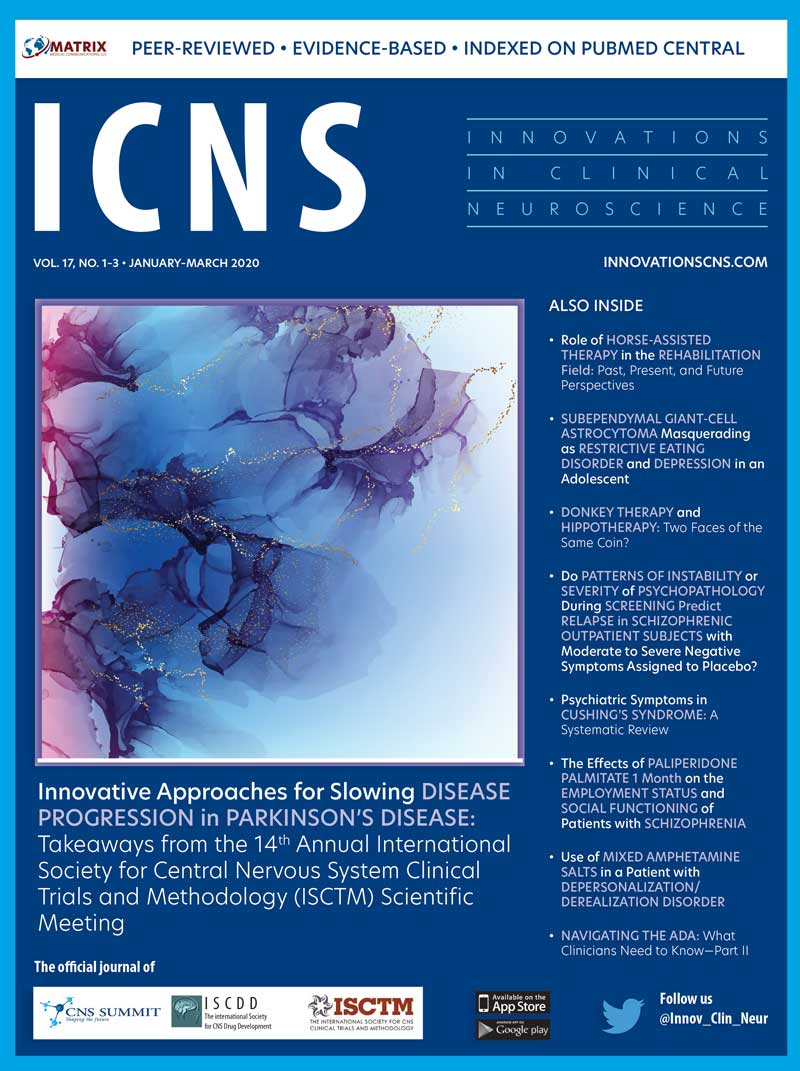 Dear Colleagues:
Dear Colleagues:
Welcome to the January–March 2020 edition of Innovations in Clinical Neuroscience (ICNS). I’d first like to inform our readers that starting this year, ICNS will move from a six-times-per-year frequency to four times a year. However, while you will be receiving a complete issue of ICNS less frequently than in years past, we will be packing more peer-reviewed, evidence-based information into each issue than ever before. Additionally, we will be pre-releasing accepted articles throughout each quarter. The pre-released articles will be available on ICNS’s website, innovationscns.com, and their availability will be announced in ICNS’s twice-monthly enewsletter that goes out to our email subscribers. If you would like to receive ICNS enewsletters, that also contain links to the latest pertinent news and trends in the field of neuroscience, as well as notify our readers when a new issue of ICNS is available, please visit the journal’s website and click the “Register” button on the top menu bar…make sure to click “Yes” to opt in to receiving ICNS emails. Registration is free and also allows you to access full content from past issues, which is only available to our registered readers.
And now, I’d like to introduce you to 2020’s first quarterly issue of ICNS. We start with a case report by Barnes et al titled, “Subependymal Giant-cell Astrocytoma Masquerading as Restrictive Eating Disorder and Depression in an Adolescent.” Here, Barnes et al describe how symptoms of brain tumors can be mistaken for psychiatric illness due to symptom cross-over. The authors present an illustrative case of an adolescent female patient whose subependymal giant-cell astrocytoma originally was diagnosed with restrictive eating disorder, urinary incontinence, and depression. The authors highlight the importance of obtaining brain imaging in cases in which presenting symptoms of psychiatric illness are ambiguous or present very suddenly.
Next, Budur et al share key points from presenters and audience members who attended the International Society for CNS Clinical Trials and Methodology (ISCTM) 14th Annual Scientific Meeting. In their article titled, “Innovative Approaches for Slowing Disease Progression in Parkinson’s Disease: Takeaways from the 14th Annual International Society for Central Nervous System Clinical Trials and Methodology Scientific Meeting,” the authors present outcomes, designs, statistical approaches, and biomarkers of clinical trials in Parkinson’s disease.
Following this, Calabrò et al assess the rehabilitation benefits of animal-assisted interventions for neurologic diseases in their commentary, “Donkey Therapy and Hippotherapy: Two Faces of the Same Coin?” Hippo and donkey therapies are briefly described and compared to one another in an effort to determine each therapy’s most effective applications for achieving optimal patient outcomes.
Next, in this issue’s installment of Psychotherapy Rounds—“Psychotherapy with Survivors of Sexual Abuse and Assault”— Drs. Cowan and Ashai explore the relationship between sexual assault and abuse and signs of physical and emotional trauma and posttraumatic stress disorder (PTSD). They discuss psychotherapies such as psychodynamic, trauma-focused cognitive behavioral, and eye movement desensitization and reprocessing that have been used to effectively treat psychological symptoms resulting from sexual abuse. The authors provide composite case vignettes to illustrate how each therapy may be used in this patient population.
Following this, in a retrospective analysis titled, “Do Patterns of Instability or Severity of Psychopathology During Screening Predict Relapse in Outpatient Subjects with Schizophrenia and Moderate-to-severe Negative Symptoms Who Were Assigned to Placebo?” Daniels et al examined data from a double-blind, placebo-controlled outpatient trial of roluperidone for treatment of negative symptoms associated with schizophrenia. In their analysis, the Positive and Negative Syndrome Scale (PANSS) was used to measure changes in symptoms among the patients assigned to the placebo control group of the roluperidone trial. Results from analysis of these data were used to identify risk factors for schizophrenia relapse among this patient group.
Next, in the review titled, “Psychiatric Symptoms in Cushing’s Syndrome: A Systematic Review,” Lin et al evaluated the prevalence and types of psychiatric symptoms among patients with the rare condition, Cushing’s syndrome, in an effort to determine how these symptoms might affect morbidity and quality of life. The authors also evaluated available treatments for Cushing’s Syndrome to better understand how these treatments might influence potential psychiatric symptoms.
Following this, in an original research article titled, “The Effects of Paliperidone Palmitate 1 Month on the Employment Status and Social Functioning of Patients with Schizophrenia,” Ohnishi et al analyzed the effectiveness of a one-month paliperidone palmitate formulation (PP1M) and its impact on the employment status, social functioning, symptomatology, and safety among 1,306 patients with schizophrenia.
Next, in a case report by Weber titled, “Use of Mixed Amphetamine Salts in a Patient with Depersonalization/Derealization Disorder,” the author describes a case of a 35-year-old female patient who presented with symptoms of depersonalization/derealization disorder (DDD) and was successfully treated with amphetamine salts. The author highlights that, currently, there are no FDA-approved pharmacological treatments for DDD, underscoring the need for more research exploring different treatment modalities.
We wrap up the issue with Part 2 of a previous Risk Management article titled, “Navigating the ADA: What Clinicians Need to Know.” Here, Vanderpool provides more information about the medical legal rights for patients with disabilities including hearing and seeing impairments and impairments requiring the use of service animals.
As always, we hope you enjoy this issue of ICNS, and we look forward to receiving your feedback and submissions.
Sincerely
Amir Kalali, MD
Editor, Innovations in Clinical Neuroscience





